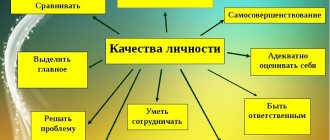Many people are interested in S. Freud's ideas about the structure of the human mental world, its conscious and unconscious components. A group of researchers has formed in the psychological community who took Freud’s theory as the basis for developing their own concepts. One of the followers of S. Freud was K.G. Jung. He studied the mental organization of personality, identifying various types of archetypes in its composition.
Archetypes
What is an archetype in psychology and philosophy
An archetype is the sum of innate layers of the unconscious containing predisposing factors that force a person to choose specific types of reactions to what is happening. Archetypes determine individual emotional experiences of the individual.
Jung believed that everyone has innate psychostructures, their content is inherited. In the psychological literature devoted to archetypal psychology, there are brief explanations of the motives of human behavior by human archetypes. So, psychologists have formulated a definition of what an archetype is.
However, not only psychologists tried to find an answer to the question of what an archetype is. In philosophy, an archetype in late antiquity was a prototype of something, as well as a description of repeating elements in a sequence of events. Archetype is one of the concepts associated with cultural studies in philosophy.
Additional Information. In various philosophical schools, researchers have expressed ideas that emotional reactions, cognitive abilities, behavioral stereotypes, and thinking styles have genetic roots.
In psychology, the theory of archetypes confirms this.
Which of the 12 archetypes do you belong to – A Real Me
The test will take you 10–15 minutes, you need to answer 12 questions. The number of responses to each statement varies. It’s interesting that all the questions revolve around one topic – flying on an airplane. But they relate to different human reactions and behavior in a specific situation. For example, where you will sit on the plane or what you will do after takeoff.
In such a critical situation, especially if a person is terribly afraid of flying, all real, sincere emotions are visible, which determines the model of behavior. An entertaining questionnaire.
What I especially liked about the test was the design: it’s immediately clear who you really are. I saw that I was a “Hero”. Even the picture is so militant! Then the life goal is succinctly and clearly described, and then talent and greatest fear. It was interesting to read... After this, a description of the main characteristics of the type, qualities, habits, and behavior is given.
The results are presented according to a clear structure, everything is clear, and no unnecessary questions arise. So feel free to take the survey. And don’t forget to write in the comments which of the proposed tests you liked the most!
Take the test→
Jung's Basic Archetypes
Self-knowledge - what is it in psychology and philosophy
Personality archetypes, speaking in the language of psychology, are the result of the work of consciousness. They contain a connection between simple mythological images stored in the unconscious layer and the cognitive actions of the individual.
Basic examples of archetypes according to Jung are self, sage, anima, animus, shadow, persona:
- Self. This is a prototype of personality integrity, uniting its conscious and unconscious components. He is responsible for the balance of personality traits.
- Sage. It is characterized by the predominance of the spiritual over the material. Such people are calm and attentive. In interpersonal interactions, they give the impression of an uncommunicative, cold person, but in reality this is not so: sages are alien to idle talk, but they will eagerly join in a constructive, highly intellectual conversation if you bring them up to date. They like to do science, create something new on their own, and help others.
Sage
- Anima. It characterizes the presence of feminine traits in a male character. The degree of its severity determines the stability of a man’s mood, his level of emotionality, and his ability to express his feelings. Men whose anima is pronounced are irritable, quick-tempered, and easily excitable.
- Animus. The prototype determines the presence of masculine qualities in a woman. The degree of its expression determines a woman’s analytical abilities, her rationality, and balance. An interesting fact is that the animus can have different polarities: positive or negative. The positive one determines the girl’s law-abiding behavior, and the negative one pushes her to various reckless actions.
- Shadow. This is a structure that explains a person’s negative personal characteristics. The individual carefully hides them. The shadow is also responsible for a person’s aggressive actions, his unacceptable thoughts and passion.
- A person. It assumes that a person has different behavioral stereotypes. The more developed a person is, the more social masks and images a person has. A persona manifests itself only in a group and is designed to facilitate social interaction.
Important! Archetypal structures are not patterns of behavior given to a person once and for all. They can change as a result of the individual’s communication with significant adults. Their change is a source of change in a person’s life.
Archetypes according to Jung are divided into feminine and masculine.
Feminine archetypes
By female archetypes, Jung understood a woman’s inherent program of self-realization, which stimulates her personal growth. She represents the scenario of a woman's life. Jung's female archetypes are :
- Eve. This is the archetypal image of a simple woman, capable of giving birth and raising a child, creating comfort in her home, and taking care of her husband.
- Elena. The presence of the image of Elena in the unconscious layer gives a woman eroticism and sensuality. She is fluent in the art of seduction, she likes to conquer men's hearts. However, in order for family life to develop successfully, such girls need to connect the Eve archetype to the dominant archetype of Elena.
Archetype Elena
- Maria. This is an image of immaculate virginity. Men rarely see her as a life partner or lover. But she can become a reliable, loyal friend for any guy.
- Sofia. This is a manifestation of feminine wisdom. Such girls belong to sensitive people who have well-developed intuition. If a quarrel breaks out in their presence, they are able to help the conflicting parties make peace. Innate wisdom helps to maintain mutual understanding and friendly relations with your husband, and to successfully raise children.
Attention! If a girl has one of the unconscious images listed above coming to the fore, this does not mean that she does not have other images. Under certain circumstances, the dominant archetype may fade into the shadows, giving way to another image that will be more relevant at the moment. To find happiness, a woman needs all 4 female psycho-images and their skillful, conscious use.
Male archetypes
The linguistics of Jung's theory offers the following images to characterize male archetypes:
- Warrior. It is characteristic of a young man who strives to win at any cost. In achieving the goal, he uses all available methods and means, strives for self-improvement and self-development.
- Monarch. This is a good leader, both at work and at home. Such a man has rational thinking and loves order. He readily takes responsibility for any assignments.
- Merchant. This image is characteristic of cunning and calculating young people. They calculate the outcome of a situation, know how to be flexible in communication, and have developed communication skills. As a rule, they quickly move up the career ladder.
- Peasant. Such a man is ready to work hard for the benefit of the family. He likes stability. He may express dissatisfaction with the level of wages, but he will not take decisive action to earn more, because he is afraid of losing what he has.
- Philosopher. This is the image of those young people who are easily inspired by new ideas and love to master new activities. They like to ask questions about the meaning of life, love, death.
- Monk. It is characteristic of obsessed people who are ready to sacrifice their lives to serve one or another idea.
Monk
- Servant. The image characterizes a weak personality. Such men find happiness next to strong women. They are never leaders. Fearing to express their opinion, they agree with the proposals of a more authoritative person.
Attention! If the signs of a particular archetype clearly come to the fore in an interlocutor or work colleague, you should not draw hasty conclusions - it is quite possible that the person purposefully chooses a model of behavior, wanting to achieve a specific goal.
Anima
Anima is actually an archetype of women, that is, the unconscious area of the female personality, the image that is transmitted to the girl from her roots and absorbed into her subconscious. This image has a huge influence on a woman’s fate; it defines her behavior scenarios, social type and character model.
The archetypal psychology of a woman is based on her nature, a set of psycho-emotional qualities, reactions, instincts, rules and beliefs that were not the result of life experience.
Amazon
An Amazon is a woman who will never become a housewife. Active, independent, militant and courageous, she knows what she wants from life, and she goes for it herself. He doesn’t ask for anything, doesn’t forgive mistakes, isn’t afraid of failures.
Such a woman is always at the top, she is the best in any team, but she is not used to “grazing the rear.”
She can be rude, sarcastic, sarcastic, but she always gets her way. The Amazon manages to do everything: take care of herself, develop as a person and build a career, and also relax in style.
She does not strive to get married; children and family often cause her despondency rather than inspiration.
Geisha
A geisha (or hetera) is a beautiful woman who is admired by people around her, and they say about her that she is a “breed”.
Refined, refined, with innate excellent taste, Geisha loves and knows how to enjoy life.
Does not like to get attached and be dependent or controlled, strives for independence. This woman knows how to achieve her goal, but rarely sets big goals - she mainly strives for comfort, luxury and a beautiful life, but with age her course may change.
Woman Sorceress
The Witch (or Priestess) woman is a person whose archetypal psychology is very deep and complex.
It seems that this lady knows everything about everyone and sees the whole world through and through.
She knows how to penetrate someone else's consciousness and find out all the secrets, and psychology for her is not a science, but natural knowledge about people.
The doctrine of archetypes greatly distinguishes this species from the rest, since it can have different development scenarios. A sorceress can become unapproachable, cold and lonely if she gets bored with the world, when she fully understands it and there are no mysteries left for her.
Or she can turn into an imperious, all-powerful and achieving lady, whom everyone around will fear and respect.
Archetype of Mother and Wife
He is different from all the others in that the Mother is not focused on her own happiness, but on the happiness of other people. She was born to give birth to boys and girls, to love them, raise them, adore her husband and make him happy, take care of all living beings and help literally everyone, and to the detriment of herself.
The classic archetype of the Great Mother is quite common; it is characterized by sacrifice, altruism, and the principle “not for oneself, but for others.”
Such a woman is happy in her marriage, but she lacks a sense of self-worth, and from this she often suffers, becoming a victim.
Queen female archetype
How to recognize and decipher an archetype
You can learn to recognize and decipher the archetypes of the people around you if you become familiar with the basics of analytical psychology in general and the teachings of K.G. Jung in particular. The works of this psychologist and his followers contain a description of not only male and female archetypes, but also other innate archetypal principles of personality that are not related to gender.
Volitional personality traits - what is it in psychology, their formation
Understanding the key fundamentals of archetype theory can give a start to a person's personal growth. Knowing the characteristics of archetypes, an individual begins to better understand himself and those around him.
Additional Information. In order to determine your own dominant archetypal image, you can perform a psychological test. To do this, it is not necessary to contact a qualified psychologist - such tests are freely available on the Internet. The interpretation of the results and recommendations in them are written in accessible language that is understandable to everyone.
Content
- Personality structure according to K. Jung
- Archetypes
- Introverts and extroverts
- Differences between Freud's psychoanalysis and Jung's analytical psychology
Carl Jung (1875-1961) continued the development of psychoanalytic theory. He collaborated with Sigmund Freud and played a leading role in the psychoanalytic movement. But later Jung did not follow Freudian traditions, but went his own way, creating an analytical direction. Therefore, the collaboration between Freud and Jung was not so long.
Archetypes and transactional analysis
Depression - what is it in psychology
Transactional analysis is a direction in psychology in which much attention is paid to describing the behavioral characteristics of an individual and the reasons that give rise to certain human reactions to what is happening. Transactional analysis is based on the concept of archetypal structures in the unconscious layer of the psyche. Thus, the theory of archetypes in transactional analysis allows:
- Understand the logic of a person’s behavior and assume how he will react to this or that information or event;
- Increase the productivity of a person’s work by determining what is the current motivator for him;
- Identify psychological barriers that interfere with a person’s professional activities and interpersonal communication;
- Make a plan for personal or career growth;
- Develop communication skills and the ability to establish partnerships with any person;
Partnerships
- Develop a winning image.
Ego or "I"
The ego is the center of the psychic sphere. Here is the point of observation of the conscious “I” over the internal and external worlds. This is where the path of personality development or “individualization” begins, as Carl Gustav Jung defined it.
Individualization is the merging of consciousness and the unconscious in one single structure - the archetypal image of the Self .
Anima in the image of Eurydice, rescued from the underworld by Orpheus.
Archetypes in branding
The concept developed by K.G. Jung, has found practical application in an industry such as branding. Archetypes in branding are used to create a unique image of a company, product or personality. Based on the use of ideas from the theory of archetypes in business, you can:
- In a short time, draw up a psychological portrait of the client, defining his value system. This information is necessary in individual work with a client: it determines the style of communication between the seller and the buyer and the choice of one or another sales tactic.
- Attract the right target audience to the company.
- Develop an effective personnel policy that involves competent selection of personnel and rapid career advancement of promising employees.
- To create a psychologically healthy corporate culture of the organization.
If we explain the terms verbal, archetype, symbol, shadow, ego, we get a summary of the main ideas of archetypal psychology. In modern reality, the concept of archetypes developed by Jung finds application in many areas of economic life.
Archetypes in life
Influence
Archetypes are still studied and used in various fields of science and human life. Archetypal pedagogy emerged. This is a direction that helps a teacher grow in the spiritual and psychological sphere.
In 2001, a book was published that described archetypes in brand marketing. It is called "Hero and Rebel". One of the authors was Carol Pearson (creator of the archetype questionnaire). The main idea of the book was that the winner is the brand that uses established images in its advertising that bring them closer to archetypes.
A psychological test will help determine the archetype. It contains simple questions that must be answered completely honestly. This will help determine the potential, capabilities, strengths and weaknesses of the individual.









